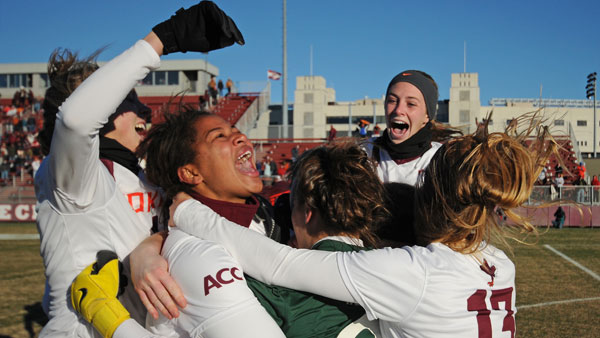What the NCAA schedule change debate means for the women’s side

Lost in the excitement over the proposed schedule change to NCAA Men’s Soccer is a very real concern: What about the women? Will the change be, as Andrew Das of the New York Times speculated, “a Title IX lawsuit waiting to happen?” Or will the women quickly join the men in adopting a fall to spring schedule?
 UCLA head coach Amanda Cromwell says that while some within the women’s game have been involved in discussions about the proposed schedule change, any decisions about adoption are still a ways off.
UCLA head coach Amanda Cromwell says that while some within the women’s game have been involved in discussions about the proposed schedule change, any decisions about adoption are still a ways off.
“The men are definitely spearheading it, but…we’re trying to decide if it’s something that both men’s and women’s soccer should do,” Cromwell told SoccerWire.
In an interview with SoccerWire, Jeremy Gunn of Stanford Men’s Soccer suggested that the women would follow the men in adopting the proposed schedule. Gunn pointed out that other women’s sports, including basketball and softball, have often adopted changes first made in the men’s games.
+READ: Proposed NCAA schedule change has major upside, college coaches say
However, with few professional teams recruiting young women athletes before college – Lindsey Horan’s six-figure move to French club PSG remains an outlier – the college path is still the best option for most of America’s top female soccer players. So long as young talents like Mallory Pugh are committing early to schools like UCLA, there will be little external pressure to change the women’s schedule.
Gunn recognizes this, pointing out that the pressures necessitating the schedule change are much different for men’s soccer than for women’s.
“You’re looking at the incredible need for change both for the student-athlete and for the sport and because of the outside pressures,” he said. “The women’s game doesn’t have as many outside pressures as we do. But I think the positives of change would mean that they would follow suit.”
Cromwell concurs with Gunn’s assessment, noting that the pressure from professional leagues that exists on the men’s side just isn’t there on the women’s.
“There’s more of an urgency for the men based on a lot of players going pro before going to college,” she said. “I think it might help their prospects of keeping players in the college game. We don’t necessarily have that same urgency.”
Still, Cromwell believes that the proposed changes could have an enormous impact on the quality of life of her players.
“In our sport, we’d love to see it be a one-game-a-week kind of schedule. Right now, [for] the student athletes a lot of injuries are happening in the fall because of the demands. For a student-athlete’s welfare [the extended season is] a better situation,” she said.
+READ: Cal’s Kevin Grimes stands up for NCAA as pro incubator
“When you look at injury prevention and quality of life, I think that would be enough for the women’s game to notice and say, hey, this looks like a good idea,” Gunn said.
According to the proposal presented to the MLS Technical Committee, the new men’s soccer schedule would have benefits that go beyond simply aligning the college game with the professional. It argues that the periodization of the schedule will permit more training, limit travel for players, provide a longer competitive season, and lead to a better on field product. As UCLA’s Cromwell points out, all of these benefits could have a tangible, long-lasting impact on the women’s game as well.
 But not everyone involved in the college game thinks the proposal is a slam dunk. Former Notre Dame head coach Randy Waldrum, while adamant that the change would positively impact the women’s game, remains skeptical that the proposal will be implemented by the NCAA.
But not everyone involved in the college game thinks the proposal is a slam dunk. Former Notre Dame head coach Randy Waldrum, while adamant that the change would positively impact the women’s game, remains skeptical that the proposal will be implemented by the NCAA.
“I hope they get it. I think it’s needed. I think if the men do it then certainly the women will follow suit,” Waldrum told SoccerWire. “I’m not real optimistic – just knowing how the NCAA has been working in the last [few] years – that it’s really going to gain enough traction to go anywhere.”
As currently proposed, the full men’s soccer calendar, including preseason training and the College Cup playoffs, would stretch from late August until early June. The fall calendar would include fifteen matches, while the spring calendar would include ten matches and playoffs. There would also be a maximum of three allowable mid-week games each semester.
Proponents of the schedule change hope to present the formal plan to the NCAA this fall, with a decision coming in early 2015.











